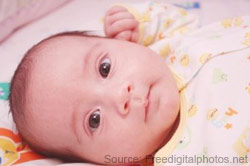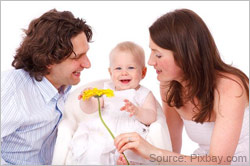
Since the arrival of your baby, you have done everything you could to
create a warm and loving haven for his first few months of life. However, now
that your bundle of joy has become mobile, your seemingly safe home suddenly
appears to be a hazard waiting to happen.
Fortunately, baby-proofing your
apartment does not have to be a stressful and harrowing experience. With a
little knowledge, shopping and preparation, you can make your rental baby-safe
in no time.
Inspect at your baby's eye level.
The first step you should take
to make your apartment safe is to get down on the floor so you can the world
from your baby's point of view. There may be many hazards lying around that you
may not even notice when you are standing. Nail heads protruding from wooden
floorboards, stray wires, or small objects that can easily fit inside a baby's
mouth are some common hazards to look out for.
Cover sharp edges and corners.
Rectangular tables with rough or
sharp edges can be very unsafe for babies learning to stand and walk. Consider
trading any tables with pointed, square corners for round tables, or purchase
safety guards. These soft foam pieces protect your baby's delicate head from
injury on sharp table corners and edges by adhering to the surface easily. They
are also often removable and reusable. However, be aware that the sticky
adhesive could leave behind an unsightly residue on the surface of your table or
ruin the finish.
Block stairways with gates.
A baby gate is essential to keep
your youngster off of dangerous stairs and confined to safe play areas. There
are two types of gates--hardware gates and pressure gates. Hardware gates, while
safer and more secure, are installed by drilling them into the wall--which may
not be permitted in a rental. While a pressure gate is safe to block a baby on
level ground or at the bottom of the stairs, the gate may topple over at the top
of a staircase. If you have a set of stairs in your rental, ask your landlord
about the possibility of installing the hardware gate--offer to fill and repaint
any holes left behind, or pay to have it done. You can also try this handy tip:
securely attach wooden boards to your railing with cables, and drill the gates
into the boards. Then simply untie the cords to remove the gate.
Pressure
gates can leave behind dents or tear wallpaper as well, which you may have to
repair if you expect the return of your security deposit.
Cover electrical outlets
Any floor-level unused electrical
outlets should always be covered to prevent your baby from sticking his fingers
or foreign objects inside. If outlets are in use, make sure they are blocked
from his access so he cannot play with the wires or pull the plus out of the
outlets. There are a variety of outlet covers on the market to choose from, such
as sliding covers--they automatically slide over the exposed outlet after you
remove a plug.
Install baby cabinet locks.
Babies have endless curiosity--and
anything within their reach is fair game. When purchasing locks to secure your
cabinet doors from your baby's prying hands, make sure that you will not be
required to screw them into the cabinetry. There are numerous safe and removable
baby-proof cabinet door locks that attach with magnets or adhesive instead. If
you have handles on your cabinet doors, you can secure them even more easily
with simple latch-like locks that loop through the handles. Even after securing
your cabinets with locks, be sure to remove all toxic and hazardous cleaning
products and chemicals from underneath the sink or other ground-level cabinets.
Instead, place these items in high-reaching cabinets, and stow pots, pans, and
other unbreakables in lower storage.
Secure windows.

Often overlooked, an unsecure window can pose a very
serious threat to your baby's safety. Never keep your baby's crib or any other
climbable furniture near a window, and never leave a window open when leaving a
room. You can also purchase window guards that fit inside the frame to keep your
baby falling out of an open window. However, these often have to be drilled into
the window, so you may have to discuss the option with your landlord prior. As
an easier and less permentant alternative, you can install safety netting on the
window--these work well on balconies as well.
Additionally, beware of
blinds--they can create a strangulation danger if your baby gets her head caught
or tangled in the pull cord. You can install window cleats to keep the cord out
of your baby's reach, or cut looped cords and attach safety tassels at the ends.
Use door knob covers and locks
Once your baby begins to toddle
around your apartment, his fingers will begin to reach for door knobs and
latches. There are a variety of safety products available to keep your baby from
opening doors, pinches his fingers, or even turning the door knob. The front
door, bathroom door, basement door and any sliding doors that lead outside or
onto your balcony should all be sufficiently secured. You can also purchase
alarms that will alert you in the event that your baby manages to pry a door
open.